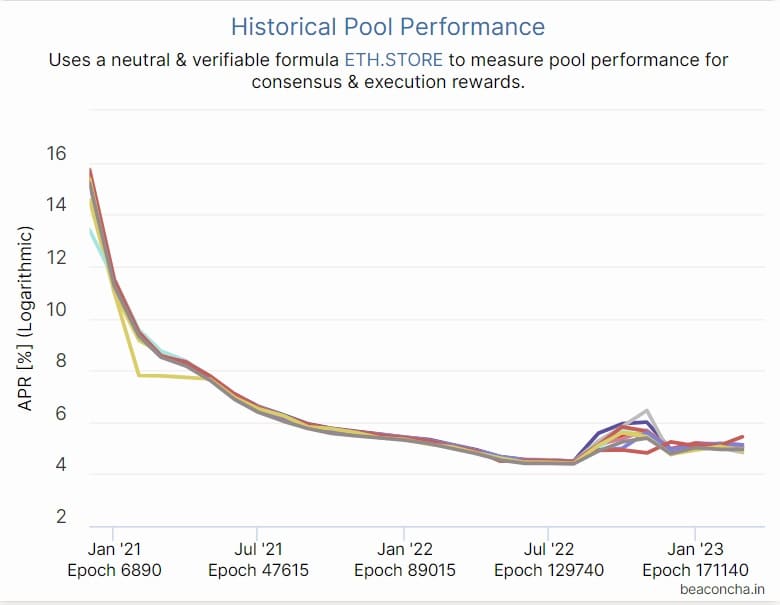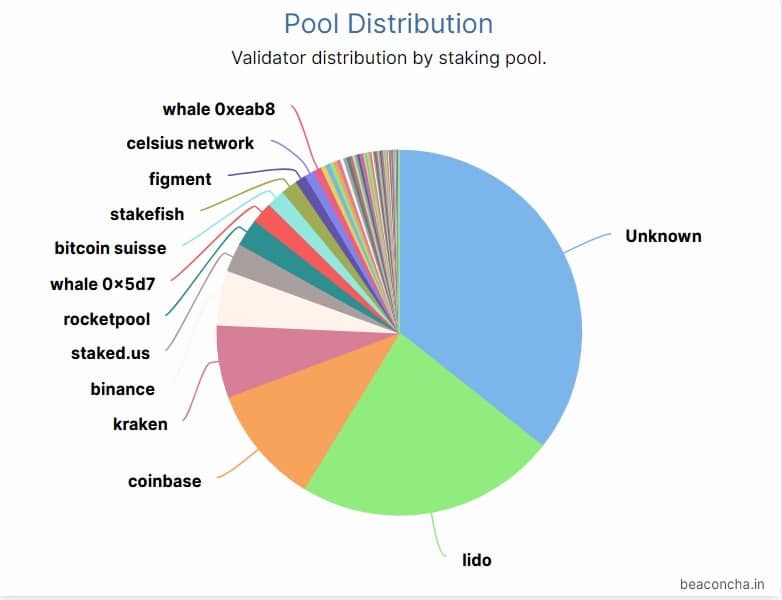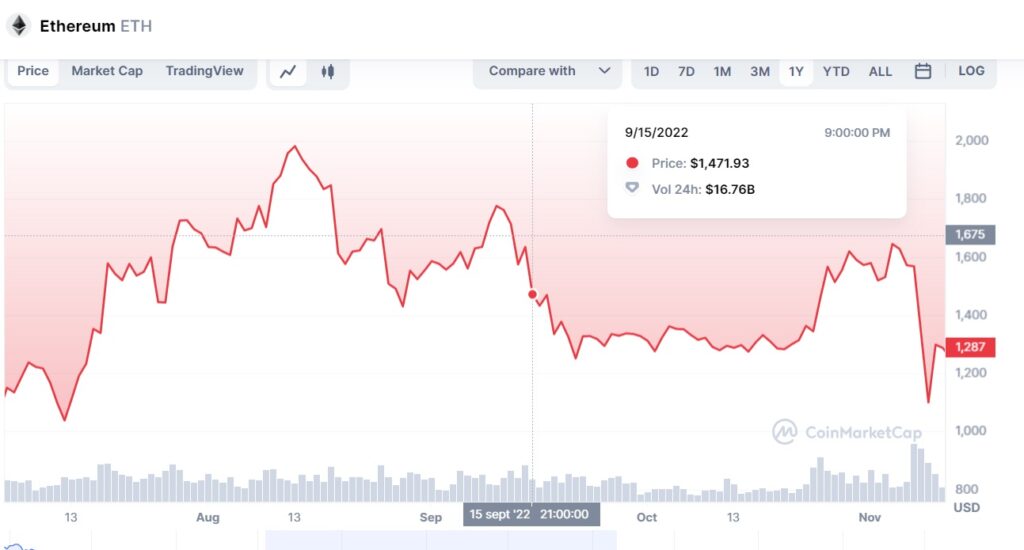Important facts:
- Enabling withdrawals does not necessarily result in a mass exit of validators.
- A million ETH could hit the market, although it depends on what the validators decide.
Ethereum will make a big change in its network starting April 12th. On this day, the Shapella update will be activated, which will allow staking funds to be withdrawn by validators.
Taking that into account exist 558,000 validators on Ethereum, it makes sense that any news related to her will raise expectations. However, there are still false or exaggerated assumptions about Shapella and its aftermath.
What changes when Shapella is activated
At the moment of arrival in the Epoch 194048the Shapella update is activated on Ethereum. Since then, validators can withdraw Ether (ETH) which you stored when staking out the network.
When Ethereum stopped mining and started working with Proof of Stake (Proof of Stake or PoS), validators became responsible for approving transactions and validating new blocks. To do this and receive rewards in return, they had to deposit 32 ETH in a smart contract (the one on the Beacon Chain, the original fragment of Ethereum with PoS) or join a staking pool.
From December 2020 to the completion of this note, 17,855,784 ETH were deposited in Ethereum staking; They equate to more than $32,202 million, according to the CriptoNoticias price index.
There is one detail about 1XBET withdrawals that has not yet been confirmed by the main Ethereum developers. For example, it is not clear if all validators will be able to withdraw their ETH directly from the box or if those who previously deposited funds into the Beacon Chain will have priority. In principle there would be a priority range, as each validator is given a number index at the time of your deposit and this would determine your position in the withdrawal queue if you wish to participate.
In the publication of frequently asked questions about withdrawals in Ethereum is explained:
“Full withdrawals are possible through an exit that places the validator in the exit queue. The output queue depends on the size of the set of validators on the network. This limit exists to regulate the rate of exit and entry into the set of validators of the beacon chain.
—Ethereum Foundation, on withdrawing staked ETH.
For partial withdrawals (from the excess balance up to 32 ETH, which does not mean exiting the protocol validator), it is stated that “16 partial withdrawals are made in each batch (every 12 seconds)”. These types of withdrawals are processed automatically and can take almost five days to process them all. assure specialists. Full withdrawals are processed “much slower”.is then added.
In addition, the Ethereum Foundation speaks of a “withdrawal mechanism” for validators who leave the network. With that in mind, key companies like Coinbase and Lido (two of the main staking pools) estimated delays of days or even weeks due to expected high demand for transactions.
Will Ethereum Validators “Flee”?
All the variables mentioned in the previous point could be based on the developers intention to keep a certain number of validators on Ethereum at all times. By allowing withdrawals and giving auditors complete freedom of action, There is a risk that many will withdraw their funds and abandon network staking.
There are several reasons that could be driving this departure. First, because Some validators deposited funds more than two years agoand it is likely that they already want to realize their profits by selling this accumulated ETH.
Additionally, the interest paid by the network will decrease as more validators join the protocol. For this reason, Being a validator is less profitable today than it was months or years agoas seen in the graphic below.

And what if the validators leave Ethereum? First, it would hurt the decentralization that the network is trying to achieve. To date, 35% of validators do not belong to any staking pool (marked as “unknown” in the chart below). When these miners leave, staking pool dominance will be higher than it is today.

On the other hand, Reducing the number of examiners also has an impact on resistance to censorship. As reported in this medium, 1 in 4 Ethereum blocks is processed by validators that must comply with United States Office of Foreign Assets Control (OFAC) regulations. If the validators leaving the network are the ones who are “not reproachful”, this percentage increases.
However, it should be noted that this is not a mathematical formula. Enabling withdrawals does not necessarily encourage a mass exodus of validators It will also not endanger Ethereum.
As certain staking pools (like Lido, Rocket Pool or Coinbase) offer investors liquidity through tokens like stETH, a large number of validators may not be in a rush to recover their deposits. Additionally, Flexibility in depositing and withdrawing ETH can motivate more users to become validators of the network.
All of these are possibilities that the developers are looking into and will certainly moderate for April 12th. The truth is that the validators have the power to decide what to do with their ETH.
Will Shapella affect the price of ETH?
The supply of ETH in circulation is 122.3 million. From this amount 14.6% is deposited into network staking. These numbers speak for themselves about the impact allowing withdrawals could have on Ethereum.
Of course, it’s impossible for all that ETH to come out at once. If that were the case, the network would run out of validators and therefore would not work.
In addition, this must be taken into account ETH from validators will not necessarily flow to the market. If they decide to hold (save) them, the fact that they exit the stake shouldn’t have a huge impact on the market.
However, should there be an ETH supply shock due to validators intent to sell their rewards and consolidate profits, it could impact the cryptocurrency’s price lower.
according to a analysis From blockchain development firm Amber Group, there are over a million ETH in rewards locked in the Beacon Chain. Their estimates suggest that half (500,000 ETH) will be deposited back into network staking during this time the other 50% could turn to the market. This would represent a 0.47% increase in the current supply of ETH not tied to network staking.
Another expectation scenario regarding ETH happened in 2022, before the Ethereum merger. It has been speculated that the technological advances that the merger brought and that the reduction in supply (which is gradual rather than sudden) would result in an increase in value, which eventually did not happen when the September 15 event occurred, as can be seen in the picture below.

Ethereum, in the final sprint towards Shapella
The Ethereum Foundation clarified that ETH holders on exchanges and wallets should not do anything before Shapella. Those running their own node should upgrade their clients, they reported. In the meantime, The update has already been successfully tested on testnets such as Goerli and Sepolia.
In short, Shapella is poised to become a big event on Ethereum, but it will not necessarily suddenly change the state of the network or listing its cryptocurrency ETH. Everything depends on the behavior of the validators. We must be vigilant, but without expecting coups that are likely to be gradual rather than abrupt.